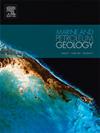Shoulder to shoulder architecture of a salt-related rift basin at the onset of continental break-up: The Central High Atlas Jurassic diapiric province (Morocco)
IF 3.7
2区 地球科学
Q1 GEOSCIENCES, MULTIDISCIPLINARY
引用次数: 0
Abstract
Continental passive margins are often defined by early salt-related rift systems buried beneath thick sedimentary piles, with structural and sedimentary architectures only directly observable when inverted in orogenic systems where primary salt structures are overprinted by compression. The Central High Atlas diapiric province (Morocco) is an inverted salt-related rift basin with active salt tectonics since early Mesozoic times that provides an exceptional view of early syn-rift sediments and structure. We present the first regional balanced and restored cross-sections of the Central High Atlas evidencing the role of salt tectonics. The cross section includes seven salt walls and six minibasins, with associated Early Jurassic to Cenozoic halokinetic strata that indicates a shortening of 38 km (24%). The Jurassic rifting stage is characterized by shallow water sediments along the basin margins and around localized salt walls, separated by minibasins filled with deep-water sediments undergoing higher subsidence rates. Subsequently, a longitudinal deltaic system prograded eastwards coevally with shallow marine deposition associated with active salt walls. Thus, local diapir uplift enhanced shallow-water deposition and local aerial exposure in central parts of the basin throughout the whole rifting stage. These features provide insights for the study of rift basins and the early stages of continental break-up worldwide, and for the exploration and production of hydrocarbons in equivalent settings.
求助全文
约1分钟内获得全文
求助全文
来源期刊

Marine and Petroleum Geology
地学-地球科学综合
CiteScore
8.80
自引率
14.30%
发文量
475
审稿时长
63 days
期刊介绍:
Marine and Petroleum Geology is the pre-eminent international forum for the exchange of multidisciplinary concepts, interpretations and techniques for all concerned with marine and petroleum geology in industry, government and academia. Rapid bimonthly publication allows early communications of papers or short communications to the geoscience community.
Marine and Petroleum Geology is essential reading for geologists, geophysicists and explorationists in industry, government and academia working in the following areas: marine geology; basin analysis and evaluation; organic geochemistry; reserve/resource estimation; seismic stratigraphy; thermal models of basic evolution; sedimentary geology; continental margins; geophysical interpretation; structural geology/tectonics; formation evaluation techniques; well logging.
 求助内容:
求助内容: 应助结果提醒方式:
应助结果提醒方式:


